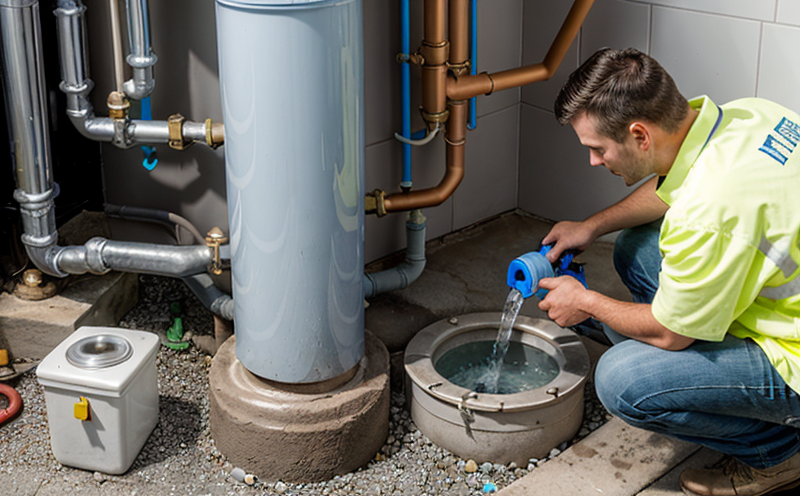ISO 4126-2 Safety Relief Valves Testing
The safety relief valve is a critical component in plumbing and water systems. Its role is to protect the system from overpressure, which can lead to catastrophic failure or severe damage. ISO 4126-2:2019 specifies the test methods for determining the performance of safety relief valves used in liquid systems.
This standard ensures that manufacturers and installers adhere to a set of stringent criteria designed to protect both the integrity of the system and the safety of those who interact with it. Testing per ISO 4126-2 is mandatory for compliance, but it also serves as an important quality assurance process.
Our laboratory strictly adheres to this standard, ensuring that all testing procedures are carried out in a controlled environment using calibrated equipment and trained personnel. The tests cover several key parameters including set pressure, discharge coefficient, flow capacity, and leakage rate under specified conditions.
The process begins with thorough preparation of the safety relief valve according to the specific requirements outlined in ISO 4126-2. This includes ensuring that all parts are clean and free from any contamination that could affect test results. Once prepared, the valves undergo a series of rigorous tests designed to evaluate their performance under various stress conditions.
The first step involves determining the set pressure by applying increasing hydraulic pressure until the valve opens as per its design specifications. The discharge coefficient is then calculated based on the flow rate and pressure drop across the valve during this opening process. Flow capacity testing assesses how much water can pass through the valve at different pressures, while leakage rates are measured to ensure there is minimal loss of fluid beyond what is necessary for proper operation.
These tests not only provide valuable data about individual components but also contribute significantly towards maintaining overall system safety and reliability. By adhering strictly to ISO 4126-2 standards, we guarantee that each valve tested meets the highest level of quality and performance expected by industry professionals.
In summary, our ISO 4126-2 Safety Relief Valves Testing service ensures compliance with international safety standards while providing comprehensive insights into the functionality of these essential components. This dedication to accuracy and precision helps maintain trust within the sector and supports continuous improvement in product quality across industries reliant on safe plumbing systems.
Benefits
- Ensures compliance with ISO 4126-2 safety standards
- Provides detailed performance data for each valve tested
- Identifies potential issues early in the production cycle
- Safeguards against risks associated with overpressure situations
- Enhances reputation by demonstrating commitment to quality assurance practices
Customer Impact and Satisfaction
By engaging our ISO 4126-2 Safety Relief Valves Testing service, customers benefit from peace of mind knowing that their products meet the highest international safety standards. This not only enhances brand reputation but also increases customer trust.
We understand the importance of reliability in plumbing and water systems; therefore, we strive to deliver accurate results promptly and efficiently. Our team works closely with clients throughout the testing process to ensure all queries are addressed and feedback is provided in a timely manner.
The outcome of this service has tangible impacts on various stakeholders within organizations involved in manufacturing or installing safety relief valves. For instance, quality assurance teams gain valuable insights into product performance which can be used for improvement initiatives. Compliance officers benefit from having reliable evidence to demonstrate adherence to regulatory requirements.
Ultimately, satisfied customers lead to successful projects and long-term partnerships built on trust and mutual respect. Our commitment to excellence ensures that every project receives the attention it deserves, leading to enhanced customer satisfaction across all levels of business operations.
Use Cases and Application Examples
The ISO 4126-2 Safety Relief Valves Testing service finds application in a wide range of industries where water systems are critical. This includes residential construction, commercial buildings, industrial facilities, and public utilities.
In the case of new residential developments, ensuring that all plumbing fixtures come equipped with properly functioning safety relief valves is crucial for protecting residents from potential hazards such as burst pipes due to excessive pressure within the system.
For commercial buildings like offices or hotels, having reliable safety measures in place helps maintain operational efficiency and occupant comfort. In industrial settings where large volumes of water are used, preventing malfunctions can save significant costs associated with downtime repairs.
In public utilities responsible for supplying clean drinking water to communities, compliance with ISO standards ensures public health remains a priority. Testing safety relief valves regularly helps identify any weak points before they become problematic, thereby safeguarding the integrity of entire distribution networks.





